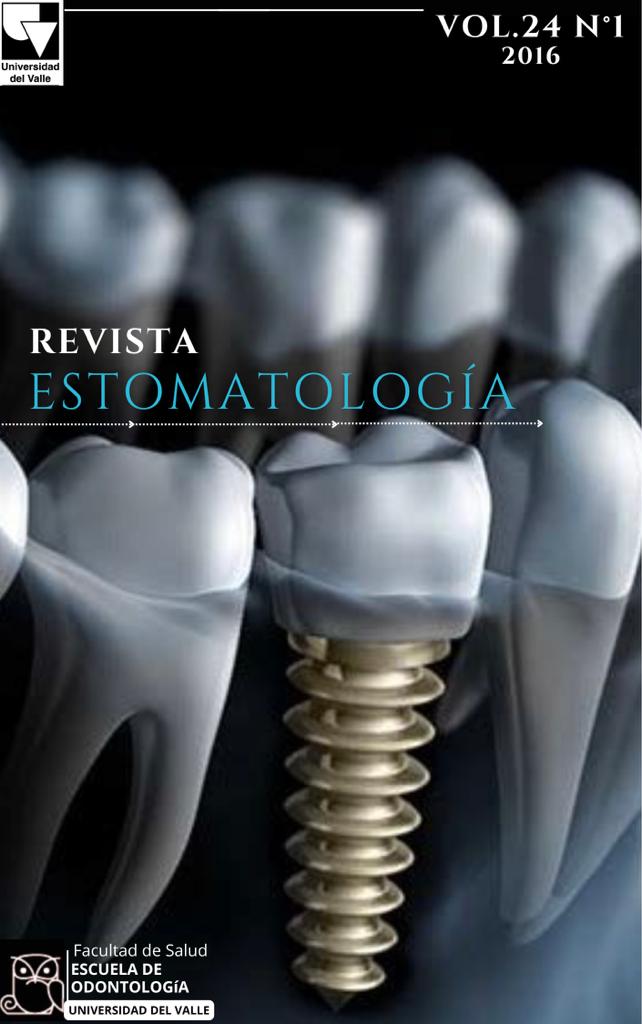Determination of changes in height and bone density after process preservation with synthetic bone substitute
Keywords:
Preservation, socket, biocomposite, chitosan, phosphateMain Article Content
Aim: Determine bone density and height reached fifteen (15) days and three (3) months after being grafted an sockets with a synthetic bone substitute and compared with experimental ceramic biocomposite.
Materials and Methods: Thirty-seven sockets (37) selected randomly were grafted in clinics of the University of Valle, sixteen sockets (16) for control group and twenty (21) for the experimental group. CT scans were performed at 15 days and 3 months post-surgery determining bone levels: vertical height and width in the grafted area; bone density is also determined by analyzing Hounsfield units. The information obtained was processed with the STATA version 13 application frequencies for gender, type of socket and type of graft used, and for numeric variables of age, bone density, bone height, thickness crestal, averages were established and deviation were calculated standard. The confidence level was set at 95% and the significance level of 5%.
Results: Bone density and height, no statistically significant differences between the intervention group (group 1) and control (group 2). For peak thickness statistically significant differences (p<0.05). The variation or change between start and end of follow within each group found that there is no statistically significant difference.
Conclusions: The ceramic biocomposite with chitosan and graft tricalcium phosphate and hydroxyapatite no statistically significant differences in density and height in the scans at 15 and 90 days. The bone width showed statistically significant differences.
2. Fickl S, Schneider D, Zuhr O, Hinze M, Ender A, Jung RE, Hürzeler MB. Dimensional changes of theridgecontourafter socket preservation and buccaloverbuilding: an animal study. Journal of clinical periodontology. 2009; 36(5):442-8
3. Fickl S, Zuhr O, WachtelH, Stappert C, SteinJ, Hürzeler M. Dimensional changes of the alveolar ridgecontour after different socket preservationtechniques. Journal of clinical periodontology. 2010; 35(10):906-
13.
4. Pagliai A. Aumento de la cresta alveolar. Trabajo de diploma. Diplôme D`Université D`Implantologie Orale et Maxillo-Faciale; 2001. p. 50-54
5. Ohura K, Bohner M, Hardouin P, Lemaitre J, Pasquer G, Flautre B. Resorption of, and bone formation from, new B-phosphate cements: An in vivo study. J Biomed Mater Res A. 1996; 30(2),193-200
6. Madihally SV, Matthew WT. Porous chitosan scaffolds for tissue engineering. Biomaterials 1999; 20(12):1133-1142.
7. Kurashina K, Kurita H, Takeuchi H, Hirano M. In vivo study of calcium phosphate cement consisting of β-tricalcium phosphate/dicalcium phosphate dibasic/tetracalcium phosphate monoxide. Biomaterials. 1997; 18(2):147-51.
8. Yao CH, Liu BS, Hsu SH, Chen YS. Calvarian bone response to a tricalcium phosphate-genipin crosslinked gelatin composite. Biomaterials. 2005; 26(16):3065-74.
9. Lim HC, Sohn JY, Park JC, Um YJ, Jung UW, Kim CS, Lee YK, Choi SH. Osteoconductive effects of calcium phosphate glass cement grafts in rabbit calvarial defects. J Biomed Mater Res B Appl Biomater. 2010; 95(1):47-52.
10. Sato I, Akizuki T. Histological evaluation of alveolar ridge augmentation using injectable calcium phosphate bone cement in dogs. J Oral Rehabil. 2009; 36(10):762-9.
11. Di Martino A, Sittinger M, Risbud MV. Chitosan: A versatile biopolymer for orthopaedictissue-engineering. Biomaterials. 2005; 26 30):59-5990.
12. Muzzarelli R. Chitosan composites with inorganics, morphogenetic proteins and stem cells, for bone regeneration. Carbohydrate Polymers. 2011; 83:1433-15.
13. Szabó G,et al. A prospective multicenter randomized clinical trial of Autogenous Bone Versus b-Tricalcium Phosphate graft alone for bilateral sinus elevation: Histologic and Histomorphometric Evaluation. Int J Oral Maxillofacial Implants 2005; 20(3):371-81.
14. Norma E. Biological evaluation of medical devices. Part 6: Test for local effects after implantation (ISO 10993-6: 1994).
15. Cruz O, González S, Moncada C. Pruebas de biocompatibilidad in vivo del fosfato tricálcico con quitosano para uso en regeneración ósea. Universitas Javeriana. 2012; 34(73):46-58
16. Jeong K . Consideration of Various Bone Quality Evaluation Methods. Implant Dentistry. 2013; 22(1): 55-9.
17. Michael R, Norton. Bone classification: an objective scale Carole Gamble of bone density using the computerized tomography scan. Clin Oral Impl Res. 2001;12(1):79-84.
Los autores/as conservan los derechos de autor y ceden a la revista el derecho de la primera publicación, con el trabajo registrado con la licencia de atribución de Creative Commons, que permite a terceros utilizar lo publicado siempre que mencionen la autoría del trabajo y a la primera publicación en esta revista.

